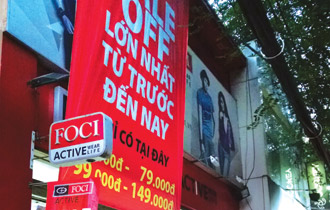|
Vietnamese fashion brands
undergoing great hardships
Not only facing big difficulties because
of the weak purchasing power, Vietnamese fashion firms also have to compete
fiercely with Chinese low-cost products to survive.

Fashion shops are deserted
despite the big sales.
Shabu Kichoo restaurant was full of customers, mostly
office workers, during the lunchtime. The Japanese styled restaurant chain
proves to be very prosperous with three shops opened in
The owner of the chain is a well known person in the
fashion industry, who founded Foci, a well known Vietnamese fashion brand, 15
years ago.
Making its debut in 1999, targeting medium class
customers, Foci had been growing very rapidly with 60 shops opened by 2007.
However, Foci’s network has gradually got narrowed over the last two years.
The company once saw the turnover tumble by 50 percent.
In late 2012 and early 2013, the owner of the Foci shop
on
Ngo Thi Bau, General Director of Nguyen Tam Company,
the owner of Foci brand, has decided to shift her business to restaurants and
international schools.
Bau has set up three restaurants so far, including the
ones at Kumho and Vincom buildings, and the other newly opened in district 7.
Bau still continues her job in the fashion industry.
However, Foci now does not spend money to develop the retail network any
more, but makes uniforms to the outsourced orders by the partners and tries
to sell products via Internet.
She said that investors always need large retail
premises to sell fashion products, while the retail premises rents have been
increasing rapidly, thus having put big difficulties for Foci.
Especially, Foci, like many other fashion firms, have
to struggle fiercely with the low-quality Chinese imports and counterfeit
goods. The smuggled goods, entering
“If the Chinese products were imported through official
channels, they would not be able to compete with Vietnamese products,” the
founder of Foci said.
A senior executive of Viet Tien Garment Company also
admitted that Viet Tien has to scale down its production because of the slow
sale.
He said though Viet Tien has spent money on the brand
recognition system and asked for the competent agencies’ intervention, the
company has yield to counterfeit goods.
“We have to narrow the domestic retail network,” the
executive said, adding that Viet Tien can find 150 shops that sell imitated
Viet Tien products every year.
Meanwhile, Le Tien Truong, Deputy General Director of
Vinatex, the Vietnamese biggest garment group, complained that the purchasing
power is getting weaker in the context of the economic downturn.
The domestic market got the growth rate of 15 percent
in 2013, much lower than the 30 percent growth rate in 2012.
The weak demand has made a lot of fashion brands fall
into a bad situation.
In 2011, The Blue signed a contract with Garmex Saigon,
under which the former distributes the products made by the latter. However, due
to the slow sales, The Blue had owed a big sum of money to Garmex Saigon.
NCDT
|
Thứ Bảy, 22 tháng 3, 2014
Đăng ký:
Đăng Nhận xét (Atom)
Không có nhận xét nào:
Đăng nhận xét